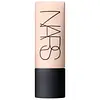What's inside
What's inside
 Key Ingredients
Key Ingredients

 Benefits
Benefits

 Concerns
Concerns

 Ingredients Side-by-side
Ingredients Side-by-side

Water
Skin ConditioningDimethicone
EmollientMethyl Methacrylate Crosspolymer
Trimethylsiloxysilicate
EmollientGlycerin
HumectantLauryl PEG-9 Polydimethylsiloxyethyl Dimethicone
Skin ConditioningSodium Chloride
MaskingBis-Butyldimethicone Polyglyceryl-3
CleansingOryza Sativa Bran Extract
Skin ConditioningHelianthus Annuus Extract
EmollientRosmarinus Officinalis Leaf Extract
AntimicrobialPlankton Extract
Skin ConditioningAlteromonas Ferment Extract
Skin ConditioningPEG-12 Dimethicone
Skin ConditioningPEG-10 Dimethicone
Skin ConditioningButylene Glycol
HumectantAluminum Hydroxide
EmollientPolysilicone-2
Disteardimonium Hectorite
StabilisingCI 77120
Cosmetic ColorantTocopherol
AntioxidantHydrogen Dimethicone
Sodium Acetylated Hyaluronate
HumectantAlumina
AbrasiveGlucose
HumectantHydrolyzed Pea Protein
EmollientSodium Succinate
BufferingPhenoxyethanol
PreservativeIron Oxides
CI 77492
Cosmetic ColorantCI 77499
Cosmetic ColorantMica
Cosmetic ColorantCI 77891
Cosmetic ColorantWater, Dimethicone, Methyl Methacrylate Crosspolymer, Trimethylsiloxysilicate, Glycerin, Lauryl PEG-9 Polydimethylsiloxyethyl Dimethicone, Sodium Chloride, Bis-Butyldimethicone Polyglyceryl-3, Oryza Sativa Bran Extract, Helianthus Annuus Extract, Rosmarinus Officinalis Leaf Extract, Plankton Extract, Alteromonas Ferment Extract, PEG-12 Dimethicone, PEG-10 Dimethicone, Butylene Glycol, Aluminum Hydroxide, Polysilicone-2, Disteardimonium Hectorite, CI 77120, Tocopherol, Hydrogen Dimethicone, Sodium Acetylated Hyaluronate, Alumina, Glucose, Hydrolyzed Pea Protein, Sodium Succinate, Phenoxyethanol, Iron Oxides, CI 77492, CI 77499, Mica, CI 77891
Titanium Dioxide 2.49%
Cosmetic ColorantWater
Skin ConditioningEthylhexyl Olivate
Skin ConditioningAmylopectin
Polyglyceryl-3 Diisostearate
EmulsifyingPropanediol
SolventDipeptide-15
Skin ConditioningSqualane
EmollientSea Salt
AbrasiveDisteardimonium Hectorite
StabilisingOpuntia Ficus-Indica Stem Extract
Skin ConditioningGlycerin
HumectantLauroyl Lysine
Skin ConditioningMagnesium Stearate
Cosmetic ColorantAluminum Hydroxide
EmollientStearic Acid
CleansingHydroxyethylcellulose
Emulsion StabilisingTrisodium EDTA
Phenoxyethanol
PreservativeIron Oxides
Titanium Dioxide 2.49%, Water, Ethylhexyl Olivate, Amylopectin, Polyglyceryl-3 Diisostearate, Propanediol, Dipeptide-15, Squalane, Sea Salt, Disteardimonium Hectorite, Opuntia Ficus-Indica Stem Extract, Glycerin, Lauroyl Lysine, Magnesium Stearate, Aluminum Hydroxide, Stearic Acid, Hydroxyethylcellulose, Trisodium EDTA, Phenoxyethanol, Iron Oxides
Ingredients Explained
These ingredients are found in both products.
Ingredients higher up in an ingredient list are typically present in a larger amount.
Aluminum Hydroxide is a form of aluminum. It can be naturally found in nature as the mineral gibbsite. In cosmetics, Aluminum Hydroxide is used as a colorant, pH adjuster, and absorbent.
As a colorant, Aluminum Hydroxide may add opacity, or reduce the transparency. Aluminum hydroxide is contains both basic and acidic properties.
According to manufacturers, this ingredient is an emollient and humectant. This means it helps hydrate the skin.
In medicine, this ingredient is used to help relieve heartburn and help heal ulcers.
There is currently no credible scientific evidence linking aluminum hydroxide in cosmetics to increased cancer risk.
Major health organizations allow the use of aluminum hydroxide in personal care products and have not flagged it as a carcinogenic risk at typical usage levels.
Learn more about Aluminum HydroxideDisteardimonium Hectorite comes from the clay mineral named hectorite. It is used to add thickness to a product.
It can also help stabilize a product by helping to disperse other ingredients.
Hectorite is a rare, white clay mineral.
Learn more about Disteardimonium HectoriteGlycerin is already naturally found in your skin. It helps moisturize and protect your skin.
A study from 2016 found glycerin to be more effective as a humectant than AHAs and hyaluronic acid.
As a humectant, it helps the skin stay hydrated by pulling moisture to your skin. The low molecular weight of glycerin allows it to pull moisture into the deeper layers of your skin.
Hydrated skin improves your skin barrier; Your skin barrier helps protect against irritants and bacteria.
Glycerin has also been found to have antimicrobial and antiviral properties. Due to these properties, glycerin is often used in wound and burn treatments.
In cosmetics, glycerin is usually derived from plants such as soybean or palm. However, it can also be sourced from animals, such as tallow or animal fat.
This ingredient is organic, colorless, odorless, and non-toxic.
Glycerin is the name for this ingredient in American English. British English uses Glycerol/Glycerine.
Learn more about GlycerinPhenoxyethanol is a preservative that has germicide, antimicrobial, and aromatic properties. Studies show that phenoxyethanol can prevent microbial growth. By itself, it has a scent that is similar to that of a rose.
It's often used in formulations along with Caprylyl Glycol to preserve the shelf life of products.
Water. It's the most common cosmetic ingredient of all. You'll usually see it at the top of ingredient lists, meaning that it makes up the largest part of the product.
So why is it so popular? Water most often acts as a solvent - this means that it helps dissolve other ingredients into the formulation.
You'll also recognize water as that liquid we all need to stay alive. If you see this, drink a glass of water. Stay hydrated!
Learn more about WaterThis ingredient is a combination of red, black, and yellow iron oxide pigments. This combination of colors is usually found in foundation, because it results in a "skin" color.